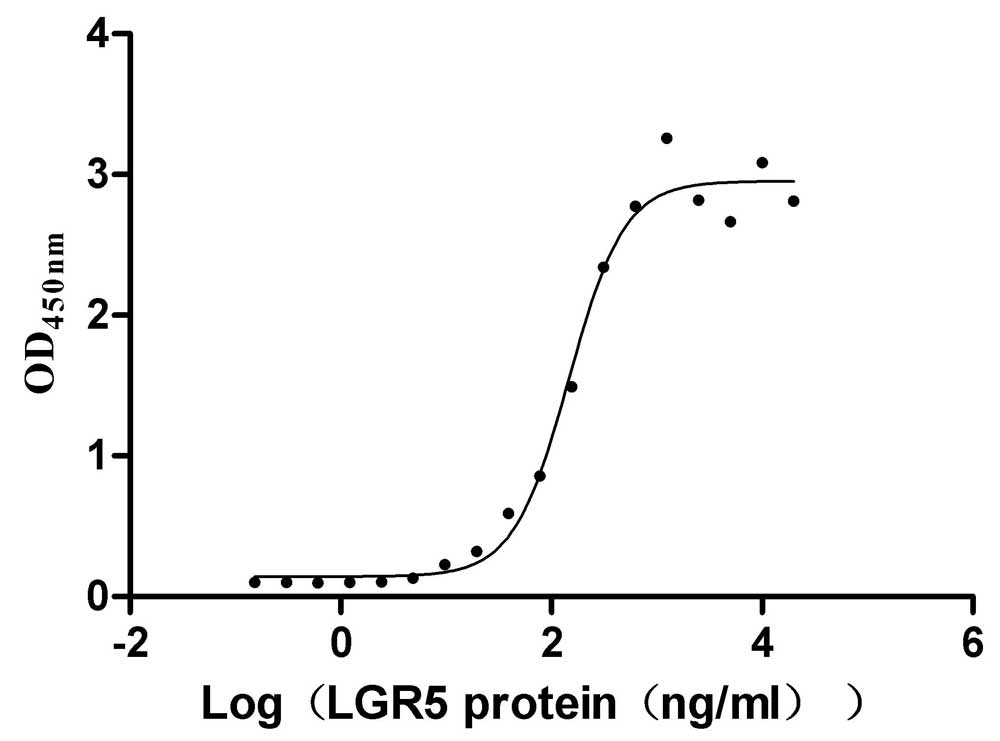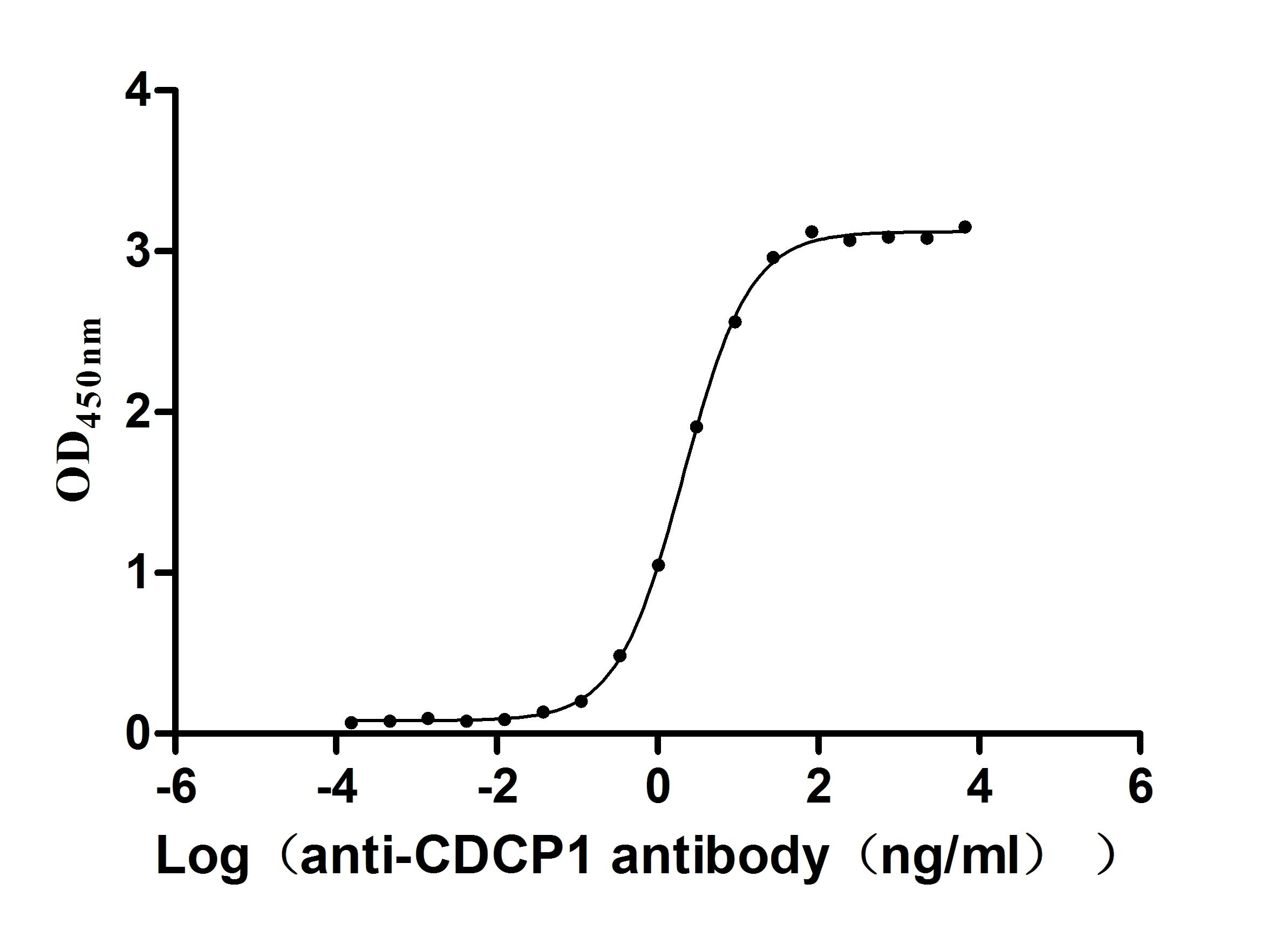Recombinant Human Ovarian cancer G-protein coupled receptor 1 (GPR68)
-
货号:CSB-CF623012HU
-
规格:
-
来源:in vitro E.coli expression system
-
其他:
产品详情
-
基因名:
-
Uniprot No.:
-
别名:GPR68; OGR1; Ovarian cancer G-protein coupled receptor 1; OGR-1; G-protein coupled receptor 68; GPR12A; Sphingosylphosphorylcholine receptor
-
种属:Homo sapiens (Human)
-
蛋白长度:full length protein
-
表达区域:1-365
-
氨基酸序列MGNITADNSSMSCTIDHTIHQTLAPVVYVTVLVVGFPANCLSLYFGYLQIKARNELGVYL CNLTVADLFYICSLPFWLQYVLQHDNWSHGDLSCQVCGILLYENIYISVGFLCCISVDRY LAVAHPFRFHQFRTLKAAVGVSVVIWAKELLTSIYFLMHEEVIEDENQHRVCFEHYPIQA WQRAINYYRFLVGFLFPICLLLASYQGILRAVRRSHGTQKSRKDQIQRLVLSTVVIFLAC FLPYHVLLLVRSVWEASCDFAKGVFNAYHFSLLLTSFNCVADPVLYCFVSETTHRDLARL RGACLAFLTCSRTGRAREAYPLGAPEASGKSGAQGEEPELLTKLHPAFQTPNSPGSGGFP TGRLA
Note: The complete sequence including tag sequence, target protein sequence and linker sequence could be provided upon request. -
蛋白标签:N-terminal 10xHis-tagged
-
产品提供形式:Liquid or Lyophilized powder
Note: We will preferentially ship the format that we have in stock, however, if you have any special requirement for the format, please remark your requirement when placing the order, we will prepare according to your demand. -
缓冲液:Lyophilized from Tris/PBS-based buffer, 6% Trehalose, pH 8.0
-
储存条件:Store at -20°C/-80°C upon receipt, aliquoting is necessary for mutiple use. Avoid repeated freeze-thaw cycles.
-
保质期:The shelf life is related to many factors, storage state, buffer ingredients, storage temperature and the stability of the protein itself.
Generally, the shelf life of liquid form is 6 months at -20°C/-80°C. The shelf life of lyophilized form is 12 months at -20°C/-80°C. -
货期:Basically, we can dispatch the products out in 1-3 working days after receiving your orders. Delivery time may differ from different purchasing way or location, please kindly consult your local distributors for specific delivery time.Note: All of our proteins are default shipped with normal blue ice packs, if you request to ship with dry ice, please communicate with us in advance and extra fees will be charged.
-
注意事项:Repeated freezing and thawing is not recommended. Store working aliquots at 4°C for up to one week.
-
Datasheet & COA:Please contact us to get it.
相关产品
靶点详情
-
功能:Proton-sensing receptor involved in pH homeostasis. May represents an osteoblastic pH sensor regulating cell-mediated responses to acidosis in bone. Mediates its action by association with G proteins that stimulates inositol phosphate (IP) production or Ca(2+) mobilization. The receptor is almost silent at pH 7.8 but fully activated at pH 6.8. Also functions as a metastasis suppressor gene in prostate cancer.
-
基因功能参考文献:
- High GPR68 expression is associated with pancreatic ductal adenocarcinoma. PMID: 29092903
- different benzodiazepines exhibit a range of biases for OGR1, with sulazepam selectively activating the canonical Gs of the G protein signaling pathway, in heterologous expression systems, as well as in several primary cell types. PMID: 29042451
- Our results suggest that OGR1-dependent increases in TRPC4 expression may favour formation of highly Ca(2+) -permeable TRPC4-containing channels that promote transformed granule cell migration. Increased motility of cancer cells is a prerequisite for cancer invasion and metastasis, and our findings may point towards a key role for TRPC4 in progression of certain types of medullablastoma. PMID: 28627017
- Blocking of GPR68 or NF-small ka, CyrillicB activity severely attenuated acidification induced IL-8 production. PMID: 27166427
- These results suggest that zOGR1, but not GPR4, is also a metal-sensing G-protein-coupled receptor in addition to a proton-sensing G-protein-coupled receptor, although not all metals that activate hOGR1 activated zOGR1. PMID: 28270026
- data identify a role for GPR68 as a proton sensor that is required for proper enamel formation PMID: 27693231
- coexpression of OGR1- and G2A-enhanced proton sensitivity and proton-induced calcium signals. This alteration is attributed to oligomerization of OGR1 and G2A. The oligomeric potential locates receptors at a specific site, which leads to enhanced PMID: 27049592
- Proton-sensing GPCR-YAP Signalling Promotes Cancer-associated Fibroblast Activation of Mesenchymal Stem Cells PMID: 27019624
- The deconstruction of OGR1-dependent signaling may aid our understanding of mucosal inflammation mechanisms PMID: 26206859
- Provide evidence for the roles of OGR1 and ASIC1a in the regulation of intestinal passive Mg(2+) absorption. PMID: 24375028
- the expression of OGR1 in myeloid-derived cells, especially in double positive cells, was required for prostate tumor cell-induced immunosuppression. PMID: 23222714
- The involvement of ovarian cancer G-protein-coupled receptor 1 in acidic extracellular environment may be an underlying mechanism responsible for bone pain in osteoporosis or bone metastasis without clinically proved fractures. PMID: 22835475
- OGR1 activation increased intracellular calcium in transfected HEK293 cells. PMID: 22508039
- It indicated that OGR1 may be a tumor suppressor gene for ovarian cancer. PMID: 21740742
- extracellular acidification induces CTGF production through the OGR1/G(q/11) protein and inositol-1,4,5-trisphosphate-induced Ca(2+) mobilization in human airway smooth muscle cells. PMID: 21907704
- acidic pH-induced vascular actions of aortic smooth muscle cells can be dissected to OGR1-dependent and -independent pathways: COX-2 expression, PGI(2) production, and MKP-1 expression are mediated by OGR1, but PAI-1 expression is not. PMID: 20622109
- ovarian cancer G-protein-coupled receptor 1 (OGR1), previously described as a receptor for sphingosylphosphorylcholine, acts as a proton-sensing receptor stimulating inositol phosphate formation PMID: 12955148
- OGR1 was found to evoke strong pH-dependent responses as measured by inositol phosphate accumulation. PMID: 15665078
- cAMP accumulation may occur through OGR1-mediated stimulation of the phospholipase C/cyclooxygenase/PGI(2) pathway PMID: 16087674
- OGR1 is a novel metastasis suppressor gene for prostate cancer. OGR1's constitutive activity via G alpha(i) contributes to its inhibitory effect on cell migration in vitro. PMID: 17728215
- OGR1/G(q/11)/phospholipase C/protein kinase C pathway regulates osteoblastic COX-2 induction and subsequent PGE(2) production in response to acidic circumstances PMID: 18302504
显示更多
收起更多
-
相关疾病:Amelogenesis imperfecta, hypomaturation type, 2A6 (AI2A6)
-
亚细胞定位:Cell membrane; Multi-pass membrane protein.
-
蛋白家族:G-protein coupled receptor 1 family
-
组织特异性:Found at low level in a wide range of tissues, but significantly expressed in lung, kidney, bone and nervous system.
-
数据库链接:
HGNC: 4519
OMIM: 601404
KEGG: hsa:8111
STRING: 9606.ENSP00000434045
UniGene: Hs.8882
Most popular with customers
-
Recombinant Human R-spondin-1 (RSPO1), partial (Active)
Express system: Mammalian cell
Species: Homo sapiens (Human)
-
Recombinant Human Angiopoietin-2 (ANGPT2) (Active)
Express system: Mammalian cell
Species: Homo sapiens (Human)
-
Recombinant Dog Angiopoietin-2 (ANGPT2) (Active)
Express system: Mammalian cell
Species: Canis lupus familiaris (Dog) (Canis familiaris)
-
Recombinant Human Microtubule-associated protein tau (MAPT) (Active)
Express system: Mammalian cell
Species: Homo sapiens (Human)
-
Recombinant Macaca fascicularis CUB domain containing protein 1 (CDCP1), partial (Active)
Express system: Mammalian cell
Species: Macaca fascicularis (Crab-eating macaque) (Cynomolgus monkey)



-AC1.jpg)

-AC1.jpg)











